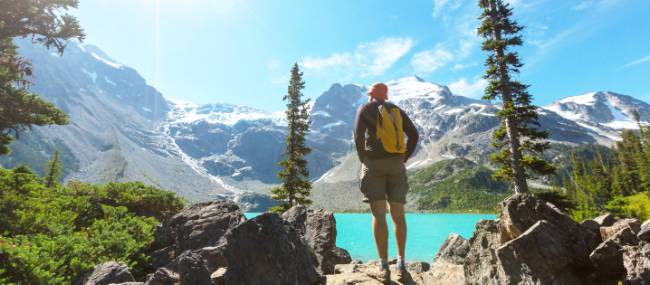
Hiker in Canadian mountains
Blog home / Gearing up for your Canadian adventure
By Robin Esrock
I remember the first time I hiked up Vancouver’s infamous Grouse Grind, a 2.5km/1.6mi leg-burner up 800m/2,625ft and over 2800 stairs. The Grind is featured in most guidebooks and tends to draw tourists with a limited understanding of what an 800-metre incline actually means. It’s a very challenging hike, especially if you’re wearing flip-flops. Because – and I am not making this up – that’s what I saw on the feet of some very perplexed visitors who likely expected a walk in the park.
Gear can make or break any adventure. This is why there are so many gear reviews in outdoor adventure magazines and websites and why there are so many products available for all levels of enthusiasts. It’s also why finding the right gear can be so overwhelming. A big hike or ride is not the right time to break in a pair of boots or discover that your new discount rainwear is too small or more porous than a sponge.

My advice: focus on the basics before getting swept down The Rabbit-hole of the Unnecessary. Does anyone really need to hike with a hand-cranked camping blender? Will you actually use that solar-powered flashlight or an 80-tool pocketknife? Start with your feet, since you’re going to be using them, for sure, a lot. Break any new shoes in on short hikes or rides, and pair them with the socks you’ll be using too, as thicker socks can quickly turn ‘just right’ into ‘too-tight.’
Are your shoes waterproof or water-resistant? Can you feel any potential blister spots? Before embarking on any trip, give yourself enough time to look after your feet, and they’ll look after you.

Next, let’s get into layers.
It's going to be hot. It’s going to be cold. It’s going to be wet. It’s going to be dry. Nobody can know what conditions you’ll encounter other than to say: there will be weather! Layering up gives you the most flexibility and generally consists of the following:
- Base layer: whether it’s thin underwear or thermals for colder adventures, your base layer should be moisture-wicking, light and versatile. Base layers come in various weights and are manufactured with various synthetic or natural materials.
- Mid layer: used to trap in heat and easily shed when you need to cool down.
- Outer layer: usually breathable and waterproof, a shell that can withstand harsh elements like rain and wind and keep you warm and comfortable.

Reader-supported Gear Lab has a helpful layer guide with product suggestions and, armed with the right knowledge, it will make visits to Canadian or online retailers easier and more efficient.
The right luggage depends on your type of outdoor adventure, but everyone is going to be on the move. We tend to overpack because we want to plan ahead for every eventuality, even the ones that seldom, if ever, come true. All Great Canadian Trails guides have first-aid kits and can typically access anything you might need. All you need to bring is your personal medication (including painkillers or antihistamines), sunscreen and bug repellant. Yes, it’s handy to have some blister strips and band-aids, but you don’t need Shoppers Drug Mart in your luggage! Packing light not only helps you move quickly, but it’s also incredibly liberating and a reminder that we don’t need nearly as much stuff as we think we do.

A carry-on bag can typically accommodate everything you need for a guided summer outdoor adventure. With more challenging hikes and destinations, you’ll encounter a wide variety of technical backpacks measured in litres. I think this is because manufacturers imagine you’ll be hiking underwater, and knowing your liquid storage capacity will come in useful. Actually, it’s how they measure the three-dimensional space of your pack. A 40 to 50-litre pack is recommended for serious hikes; a 20-litre pack is usually ideal for day trips or lighter packing.
Headlamp, water bottles, toques, cameras, hats, walking sticks, gloves, gaiters – every GCT trip will have a packing list to ensure you bring what you need and save time, effort and money leaving behind the things you don’t. We’re all individuals, and there’s always space to bring those little things that personally make a difference. In my case, I always carry a bottle of Tabasco on a hike because it spices up any campsite meal, and those thick little bottles can take a beating.

Appropriate, high-quality clothing and something to carry it in: cover the basics, and you’ll find packing for any adventure is not nearly as complicated or intimidating as you’d expect. Do some research, and if in doubt, ask your friendly Great Canadian Trails agent for proven advice from those who have blazed the trail before. Rest assured, there’s always an opportunity for flip-flops once you’ve reached the top of the mountain.
Robin Esrock is a renowned travel journalist and the bestselling author of the Great Canadian Bucket List.